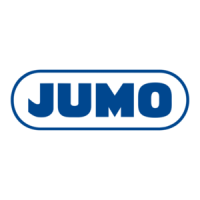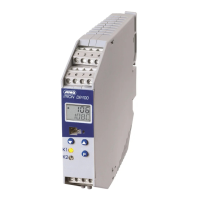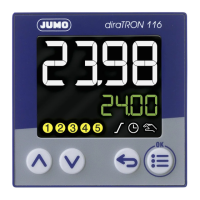31
4 Supplement
Depending on the value of the control deviation, the controller selects between two self-optimi-
zation methods:
Prerequisites
The following prerequisites must be fulfilled to be able to start self-optimization:
• Self-optimization start is not inhibited by the binary function (binF)
• Controller is in the automatic mode, not in the manual mode
• No parameter level inhibit active via setup program
• Ensure that keys (B) and (C) are not pressed one after the other. They must always be pressed
simultaneously.
Furthermore, the following points should be taken into consideration, checked and, if necessary,
adjusted, prior to starting self-optimization:
• Is the suitable controller type configured?
• Check and/or adjust the control action of the controller
• Is it possible to sufficiently influence the actual value in the manual mode?
• Only for continuous controller: The function of the output (OutP -> OutA) must be configured
as controller output 1 and scaled to 0 ... 100 %. This means:
Function (FnCt) = Controller output 1 (9)
Zero point (0Pnt) = 0
End value (End) = 100
Depending on the controller type and parameter setting, the controller structures and specific pa-
rameters are optimized:
Self-optimization in the start-
up-phase
Self-optimization at the
setpoint
wSetpoint
S Switching curve
T Start time of self-optimi-
zation
Controller type Parameter setting Optimized cont-
roller structure
Optimized parameters
2-state controller rt ! 0; dt = 0; Pb1 = any PI Pb1, rt, Cy1, dF
all other settings PID Pb1, dt, rt, Cy1, dF
3-state controller rt ! 0; dt = 0;
Pb1 = Pb2 = any
PI Pb1, Pb2, rt, Cy1, Cy2, dF
all other settings PID Pb1, Pb2, dt, rt, Cy1, Cy2,
dF
Continuous
controller
rt ! 0; dt = 0; Pb1 = any PI Pb1, rt, dF
all other settings PID Pb1, dt, rt, dF

